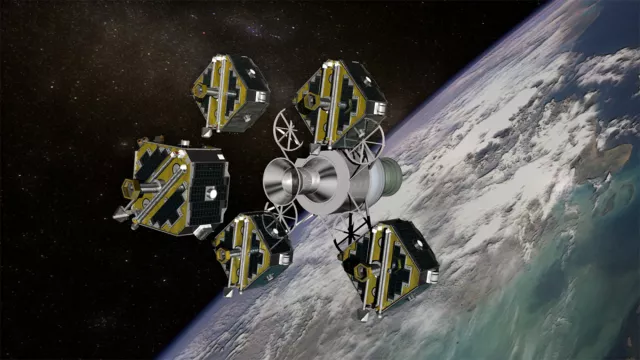The five small satellites of the THEMIS mission are probing the streams of charged particles in the solar wind that buffet Earth’s magnetosphere and generate polar auroras.
Key information
Key figures
- 5 satellites in constellation
- 5 instruments on each satellite
- 126 kg: mass of each satellite
- 2 contributing French laboratories
Key milestones
- 17 February 2017: Mission reaches 10-year mark, still operational on Earth and Moon sides
- 22 October 2010: THEMIS-C (ARTEMIS-P2) arrives in orbit around L1 Earth-Moon Lagrange point
- 25 August 2010: THEMIS-B (ARTEMIS-P1) arrives in orbit around L2 Earth-Moon Lagrange point
- 1 January 2009: THEMIS-B and THEMIS-C reassigned to a lunar mission and renamed ARTEMIS-P1 and ARTEMIS-P2
- 19 May 2008: NASA extends mission to 2012
- 15 September 2007: Satellites repositioned to study Earth’s magnetotail
- 17 February 2007: Five THEMIS satellites launched by Delta II 7925-10C
Project in brief
THEMIS (Time History of Events and Macroscale Interactions during Substorms) is a U.S. Explorer mission flying five small satellites carrying instruments conceived by U.S. scientists in collaboration with French research laboratories. The mission is operating inside Earth’s magnetosphere to study the highly explosive phenomena that trigger polar auroras, which scientists call magnetic substorms. The five THEMIS satellites were orbited together by a Delta II launcher from Cape Canaveral, Florida, on 16 February 2007.
Orbiting at different distances from Earth, the THEMIS satellites line up every four days over North America along the Sun-Earth axis, in the region called the magnetotail. This constellation of satellites has already observed first-hand thousands of substorms and the propagation of particles from the solar wind to Earth’s poles. As a result, scientists have been able to trace the point of origin of the phenomenon to a region of the magnetosphere one-third the distance from Earth to the Moon.
Each satellite is carrying five instruments, notably magnetometers, to which the LPP plasma physics laboratory (ex-CETP) and the IRAP astrophysics and planetology research institute (ex-CESR) contributed. IRAP also helped to define the mission and is involved in data analysis and interpretation.
CNES’s role
CNES is supporting the French research laboratories contributing to NASA’s THEMIS project.
Contacts
Sun, Heliosphere & Magnetospheres (SHM) subject matter expert
Kader Amsif
E-mail: kader.amsif at cnes.fr


